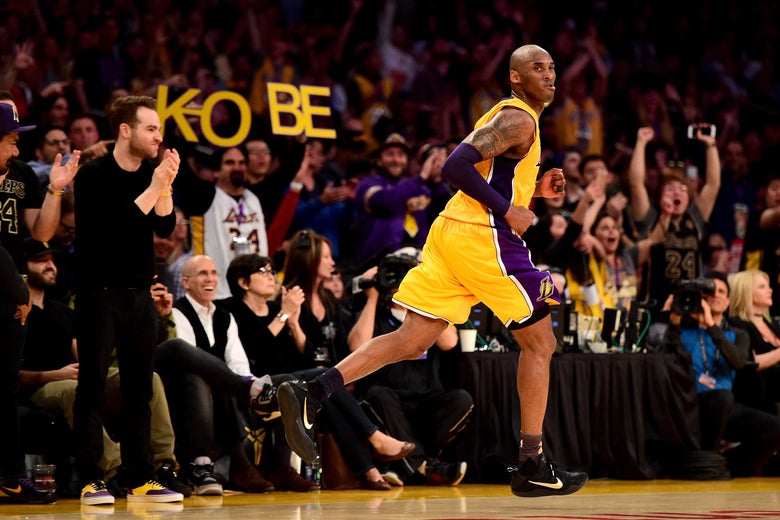
Kobe Bryant during his final NBA appearance, against the Utah Jazz at Staples Center on April 13, 2016.
Harry How/Getty Images
The news is almost impossible to comprehend. A helicopter carrying basketball legend Kobe Bryant and his 13-year-old daughter Gianna crashed into the Calabasas hillside on Sunday, killing all nine passengers on board. ESPN’s Adrian Wojnarowski reports they were traveling to a basketball game in Thousand Oaks. Bryant is survived by his wife Vanessa and three other daughters. He was 41.
Bryant spent much of his 20-year NBA career at the center of the basketball universe, and he found himself there again less than 24 hours before his death. On Saturday night, current Laker LeBron James surpassed Bryant for third place on the league’s list of all-time leading scorers. Bryant’s final tweet was a message of congratulations.
I’m not joking when I say that I expected Bryant to come out of retirement to regain his spot in the record books. He didn’t need to die in order to become a mythical basketball being, and so much of his mythos revolved around his otherworldly competitiveness.
Praise for Bryant’s basketball mania could manifest in disturbing ways: In 2004, he was lauded for playing games on the same day as proceedings in his sexual assault case. (That case was dropped when his accuser reportedly declined to cooperate with prosecutors.) Those whose antipathy for Bryant centered on his on-court persona insisted he was merely copying Michael Jordan, and that his career was dedicated to chasing a Jumpman-shaped shadow. Bryant’s fans, meanwhile, can simply point to the time he hit two free throws immediately after tearing his Achilles. The man was always trying to prove something. The only point of disagreement is over what that thing was.
When Bryant retired in 2016, he exited a league that was leaving him behind. The NBA was moving to a fast-paced style reliant on fluid passing and 3-pointers, and ball-dominant shooting guards had become as out of fashion as logo-patched jeans. Modern pro basketball prioritizes efficiency, a concept Bryant eschewed in favor of piling up points by any means necessary. He was the ultimate gunner, the kind of player who’d shoot from out of bounds if it were allowed.
There may come a day when another player scores 81 in a game, as Bryant did against the Toronto Raptors in 2006. There’s no chance they’ll do so by taking nearly three-dozen 2-pointers. It was like watching someone build a suspension bridge out of chewing gum. It was magnificent.
Kobe’s on-court persona was a Rorschach test for NBA fans. His reliance on contested jumpers was either an affront to math and common sense or a thrilling display of unabashed superstardom. That it took so long for the former camp to win this battle for the game’s soul is a testament to Kobe’s popularity and influence. “Hero ball” sounds cool for a reason.
While the current crop of NBA superstars all looked up to Bryant, few play like him. LeBron James is a pass-first point-forward. Steph Curry floats between air molecules while shooting 43 percent from deep. Bryant’s game was all maniacal persistence, like rainwater chewing at limestone. “High-volume scorer” wasn’t a pejorative term to him. It was a job description.
It was a little on the nose that Bryant’s last-ever NBA game coincided with the coronation of the style of play that usurped him. On April 13, 2016, the Golden State Warriors beat the Memphis Grizzlies to claim their league-record 73rd win. At the same time, Bryant and the 16-win Lakers took on the Utah Jazz in Los Angeles. Bryant scored 60 points in front of a raucous home crowd, on an incredible 50 field goal attempts. ESPN aired the Warriors’ record-breaking feat, and at its peak 4.2 million people tuned into watch. The ESPN2 broadcast of Bryant’s swan song, meanwhile, topped out at 5.1 million viewers. The NBA may have moved away from hero ball, but fans couldn’t look away.
Readers like you make our work possible. Help us continue to provide the reporting, commentary and criticism you won’t find anywhere else.
Join Slate Plusfrom Slate Magazine https://ift.tt/30VzVat
via IFTTT
沒有留言:
張貼留言